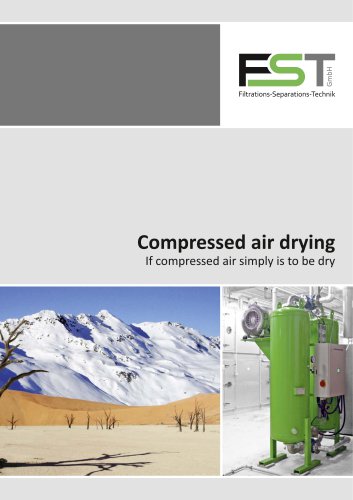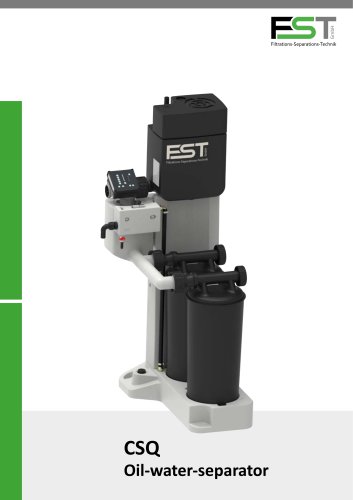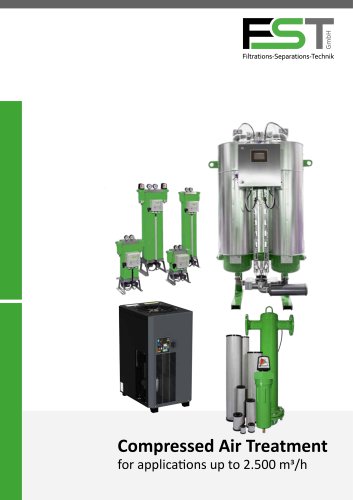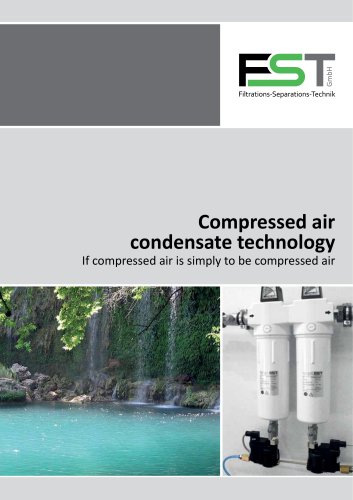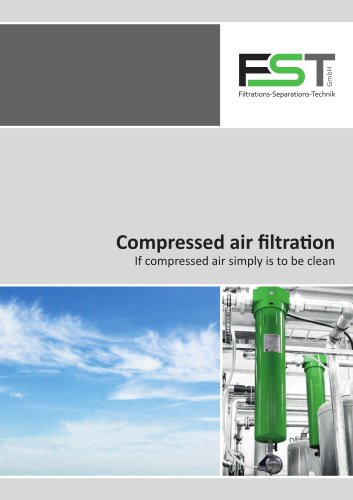 Website:
FST
Website:
FST
Catalog excerpts

Compressed air drying If compressed air simply is to be dry
Open the catalog to page 1
Why compressed air drying? Compressed air is energy in the form of compressed ambient air. Compressed air is permanently trying to expand back to atmospheric pressure and thus performs work during the expansion process. Besides electrical energy compressed air is one of the most important forms of power for industrial production processes and is widely used thanks to numerous advantages: • Can be produced locally and on demand • Can be stored easily and without losses • Can be transported easily • High amount of energy per volume • Can be easily converted to other forms of energy, e.g....
Open the catalog to page 2
Refrigeration dryer Pressure dew-points down to +3°C can be achieved with refrigeration dryers. The areas of application for compressed air dried with refrigeration dryers are generally frost-free indoor installations and compressed air applications with low requirements in terms of the degree of dryness, such as instrument air, blast air, pneumatic tools. Refrigeration dryers are usually used to centrally prepare the compressed air to a "basic degree of dryness", which is suitable for most installed compressed air applications. Higher degrees of dryness are created for individual...
Open the catalog to page 3
Refrigeration dryer Design and function Take note! Control types To prevent the refrigeration dryer from freezing when being operated at partial load, the cooling capacity generated by the refrigerant circuit needs to be controlled. Refrigeration dryers consist of two heat exchangers and a controlled refrigerant circuit. The compressed air flowing in is pre-cooled in the first heat exchanger, the air-to-air heat exchanger by the compressed air in counterflow direction, which is already cooled and flowing out. In the second heat exchanger, the refrigerant-to-air heat exchanger Q, the...
Open the catalog to page 4
The advantages at a glance Refrigeration dryer DFX, DFE Removable side panels The removable side panels allow easy and spacious access to the entire interior of the refrigeration dryer for cleaning and maintenance work. V Easy maintenance Fully integrated, completely thermally insulated heat exchanger The fully integrated aluminium heat exchangers combine all the components required for reliable and economical drying - the air-to-air heat exchanger, the refrigerant-to-air heat exchanger and the condensate separator system - in a compact, leak-free unit. The integration of all heat transfer...
Open the catalog to page 5
DFX, DFE series Pressure dew-points: Down to +3°C Volume flow rate: 20 m3/h to 1,650 m3/hConnection: G 3/8 to G 2Yi Refrigeration dryers - the minimum drying requirement for every compressed air application The advantages... S Fine model range - 22 models enable performance and cost optimised model selection V Robust metal housing - Sturdy housing with thick walls - High-quality, long life powder coating S Removable side panels - Spacious access - Easy cleaning and maintenance V Fully integrated, complete thermally insulated heat exchanger - Low differential pressure - Leak-free -...
Open the catalog to page 6
Adsorption dryer Design and function Control types Fixed cycle In fixed cycle adsorption dryers work with fixed cycle times under the assumption of permanent full load, regardless of the inlet conditions. The adsorption and regeneration phases are equally as long. Adsorption dryers consist of two pressure vessels, which are both filled with desiccant and are alternately operated via switch-over. The compressed air to be dried flows through a vessel where the moisture is thoroughly removed by the desiccant (adsorption). At the same time, the moisture stored in the desiccant in the second...
Open the catalog to page 7
Adsorption dryer Energy saving potential of the dew-point dependent control Take note! Adsorption dryers are always designed for full load operation, i.e. maximum volume flow, minimal operating pressure and maximum inlet temperature, in order to ensure the required pressure dew-point is achieved even at correspondingly high load. In full load operation, the adsorption and regeneration phases are equally as long. There is a permanent requirement for regeneration energy. However, the specified full load operating conditions rarely occur simultaneously, due to: • Seasonal and meteorological...
Open the catalog to page 8
The advantages at a glance Adsorption dryer all series Pressure vessels MADE IN GERMANY with high-quality coating Stainless steel screen and adsorption from bottom to top High-quality 2-layer desiccant bed High-quality, robust desiccants form the basis for cost-effective, efficient and stable adsorption drying. Heatless adsorption dryers from FST are filled with robust, durable and high-grade drying molecular sieve desiccant. With its large specific surface and high drying capacity, molecular sieve ensures a stable and low pressure dew-point down to -70°C. This results in long,...
Open the catalog to page 9
The advantages at a glance Heat regenerated adsorption dryer Individual valve control Each valve is controlled individually with a time-delay, which results in overlap-free switch-over without pressure peaks between adsorption and regeneration. The flow paths through the adsorption dryers are always clearly defined. This eliminates possible incorrect flow from passive devices (e.g. shuttle valves) and thereby prevents malfunction of the dryer. There is always an un restricted flow path for the compressed air, even in the case of loss of supply voltage. This ensures compressed air supply...
Open the catalog to page 10
The advantages at a glance Control units DTS..V and DTS..BVL -fast cooling in suction mode (vacuum) without purge air DTS..V - cooling with ambient air from bottom to top Cooling in suction mode with vacuum does not involve any blower heat in the cooling phase. The cooling air, which is up to 28°C cooler in comparison to the blower regeneration, facilitates a rapid and complete cooling phase - without the use of purge air (see information). Cooling without purge air has a significant effect on the energy requirement of the entire regeneration phase and thus on the When cooling with ambient...
Open the catalog to page 11All FST catalogs and technical brochures
-
FST product overview
8 Pages
-
Nitrogen generators GNA and DNM
16 Pages
-
CSQ oil-water-separator
8 Pages
-
FST distributor
20 Pages
-
FST condensate
9 Pages
-
FST filtration: FCA / FWS series
20 Pages

